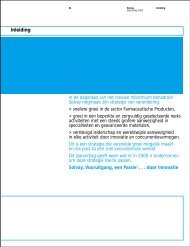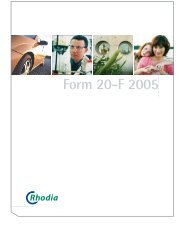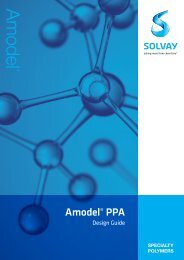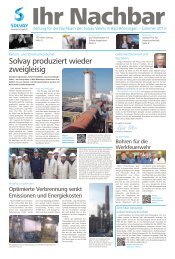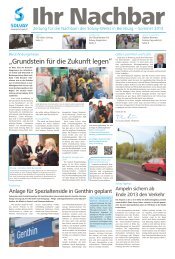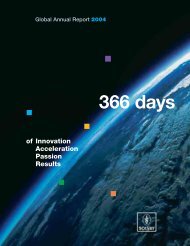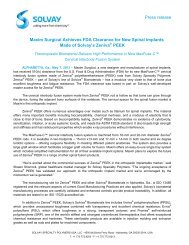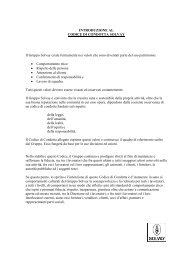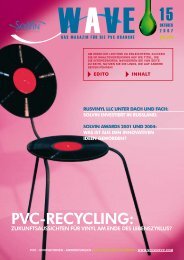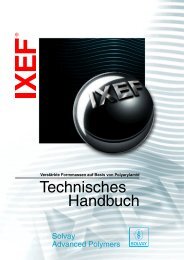CAUSTIC SODA 30 to 53 % - Solvay Plastics
CAUSTIC SODA 30 to 53 % - Solvay Plastics
CAUSTIC SODA 30 to 53 % - Solvay Plastics
You also want an ePaper? Increase the reach of your titles
YUMPU automatically turns print PDFs into web optimized ePapers that Google loves.
PRODUCT SAFETY INFORMATION<br />
This Product Safety Information does not constitute a Safety Data Sheet and shall only be used as<br />
a source of information. The relevant Safety Data Sheet is available upon mail request <strong>to</strong><br />
vinythai@solvay.com<br />
<strong>CAUSTIC</strong> <strong>SODA</strong> <strong>30</strong> <strong>to</strong> <strong>53</strong> %<br />
1. SUBSTANCE/PREPARATION IDENTIFICATION<br />
Identification of the substance or the preparation<br />
Product name : <strong>CAUSTIC</strong> <strong>SODA</strong> <strong>30</strong> <strong>to</strong> <strong>53</strong> %<br />
Chemical name : Sodium hydroxide<br />
Synonym(s) : Lye soda, Sodium hydrate, Caustic lye<br />
Formula: : NaOH<br />
Molecular Weight : 40,01<br />
EC Number (EINECS) : 215-185-5<br />
2. COMPOSITION/INFORMATION ON INGREDIENTS<br />
♦<br />
Sodium hydroxide<br />
CAS Number : 1310-73-2<br />
ID Number (Annex I) : 011-002-00-6<br />
EC Number (EINECS) : 215-185-5<br />
Symbols : C<br />
Phrases R : 35<br />
Concentration : <strong>30</strong>,00 - <strong>53</strong>,00 %<br />
3. HAZARDS IDENTIFICATION<br />
♦<br />
Corrosive product, hazardous <strong>to</strong> human health and the environment.<br />
4. FIRST-AID MEASURES<br />
General recommendations<br />
♦ Personal protective equipment required for rescuers (see section 8).<br />
♦ In case of product splashing in<strong>to</strong> the eyes and face, treat eyes first.<br />
♦ Submerge soiled clothing in a basin of water.<br />
Effects<br />
♦<br />
♦<br />
Main effects<br />
Corrosive <strong>to</strong> mucous membrane, eyes and skin.<br />
The seriousness of the lesions and the prognosis of in<strong>to</strong>xication depend directly on the<br />
concentration and duration of exposure.<br />
PSI / P 13169 / 26/11/01 / Version 1 / Edition 22.10.2001<br />
1/9
♦<br />
♦<br />
♦<br />
♦<br />
♦<br />
♦<br />
♦<br />
♦<br />
Inhalation<br />
Severe irritation of the nose and the throat.<br />
Cough and difficulty in breathing.<br />
At high concentrations, risk of chemical pneumonitis, pulmonary (o)edema.<br />
In case of repeated or prolonged exposure: risk of sore throat, nose bleeds, chronic bronchitis.<br />
Eyes contact<br />
Severe eye irritation, watering, redness and swelling of the eyelids.<br />
Burns.<br />
Risk of serious or permanent eye lesions.<br />
Risk of blindness.<br />
Skin contact<br />
♦ Painful irritation, redness and swelling of the skin.<br />
♦ Risk of severe burns; slow healing.<br />
♦ Risk of shock.<br />
♦<br />
♦<br />
♦<br />
♦<br />
♦<br />
Ingestion<br />
Severe irritation, burns, perforation of the gastrointestinal tract accompanied by shock.<br />
Abundant salivation.<br />
Risk of throat (o)edema and suffocation.<br />
Nausea, vomiting (bloody), abdominal cramps and diarrhea (bloody).<br />
Risk of general symp<strong>to</strong>ms.<br />
First aid<br />
♦<br />
♦<br />
♦<br />
♦<br />
♦<br />
♦<br />
♦<br />
♦<br />
♦<br />
♦<br />
♦<br />
Inhalation<br />
Remove the subject from the contaminated area as soon as possible; transport him/her lying down,<br />
with the head higher than the body, <strong>to</strong> a quiet, uncontaminated and well-ventilated location..<br />
Oxygen or pulmonary resuscitation if necessary.<br />
Consult with a physician in case of respira<strong>to</strong>ry symp<strong>to</strong>ms.<br />
Eyes contact<br />
Consult with an ophthalmologist immediately in all cases.<br />
Take <strong>to</strong> hospital immediately.<br />
Flush eyes as soon as possible with running water for 15 minutes, while keeping the eyelids wide<br />
open.<br />
In the case of difficulty of opening the lids, administer an analgesic eye wash (oxybuprocaine).<br />
Skin contact<br />
Immediately bring the clothed subject under the shower.<br />
Remove contaminated shoes, socks and clothing; wash the affected skin with running water.<br />
Consult with a physician immediately in all cases.<br />
Keep warm (blanket), provide clean clothing.<br />
Ingestion<br />
♦<br />
♦<br />
♦<br />
General recommendations<br />
Consult with a physician immediately in all cases.<br />
Take <strong>to</strong> hospital immediately.<br />
If the subject is completely conscious:<br />
Rinse mouth with fresh water.<br />
PSI / P 13169 / 26/11/01 / Version 1 / Edition 22.10.2001<br />
2/9
♦<br />
♦<br />
♦<br />
Do not give anything <strong>to</strong> drink.<br />
Do not induce vomiting.<br />
If the subject is unconscious:<br />
Classical resuscitation measures.<br />
Medical treatment<br />
♦<br />
♦<br />
♦<br />
♦<br />
♦<br />
♦<br />
♦<br />
♦<br />
♦<br />
♦<br />
♦<br />
♦<br />
♦<br />
Inhalation<br />
Pulmonary resuscitation (oxygen therapy).<br />
Prevention or treatment of pulmonary (o)edema and bacterial secondary infection.<br />
Rest and 48 hours medical surveillance.<br />
Eyes contact<br />
On the advice of the ophthalmologist.<br />
Skin contact<br />
Usual treatment for burns.<br />
Ingestion<br />
Oxygen therapy via intra-tracheal intubation.<br />
If necessary, tracheo<strong>to</strong>my.<br />
Avoid gastric lavage (risk of perforation).<br />
In case of intense pain: inject an I.M. morphomimetic analgesic drug (piritramide) before taking <strong>to</strong><br />
hospital.<br />
Prevention or treatment for shock.<br />
Urgent digestive endoscopy with aspiration of the product.<br />
Treatment of gastrointestinal tract burns and resulting effects.<br />
Prevention or treatment of esophagal stenosis.<br />
5. FIRE-FIGHTING MEASURES<br />
♦<br />
♦<br />
Common extinguishing means<br />
In case of fire in close proximity, all means of extinguishing are acceptable (subject <strong>to</strong> section<br />
below).<br />
Inappropriate extinguishing means<br />
Water<br />
Specific hazards<br />
♦ Non-combustible<br />
♦ Exothermic reaction on contact with water.<br />
♦ Formation of flammable gas on contact with certain metals (see 10).<br />
♦<br />
♦<br />
♦<br />
♦<br />
♦<br />
♦<br />
Protective measures in case of intervention<br />
Evacuate all non-essential personnel.<br />
Intervention only by capable personnel who are trained and aware of the hazards of the product.<br />
When intervention in close proximity wear acid resistant over suit.<br />
Wear self contained breathing apparatus when in close proximity or in confined spaces.<br />
Other precautions<br />
If safe <strong>to</strong> do so, remove the exposed containers, or cool with large quantities of water.<br />
Avoid direct contact of the product with water.<br />
PSI / P 13169 / 26/11/01 / Version 1 / Edition 22.10.2001<br />
3/9
6. ACCIDENTAL RELEASE MEASURES<br />
Precautions<br />
♦ Isolate the area.<br />
♦ If safe <strong>to</strong> do so, without over exposing anyone, try <strong>to</strong> s<strong>to</strong>p the leak.<br />
♦ Follow the protective measures given in section 8.<br />
♦ Follow the protective measures given in section 5.<br />
Cleanup methods<br />
♦ If possible, dam large quantities of liquid with sand or earth.<br />
♦ Collect the product with suitable means.<br />
♦ Place everything in<strong>to</strong> a closed, labelled container compatible with the product.<br />
♦ S<strong>to</strong>re the product in a safe and isolated place.<br />
♦ For disposal methods, refer <strong>to</strong> section 13.<br />
♦ Clean the area with large quantities of water.<br />
♦<br />
♦<br />
Precautions for protection of the environment<br />
Prevent discharges in<strong>to</strong> the environment (sewers, rivers, soils,...).<br />
Immediately notify the appropriate authorities in case of significant discharge.<br />
7. HANDLING AND STORAGE<br />
Handling<br />
♦ Dilution: add the product in<strong>to</strong> water, but never the contrary.<br />
♦ Carry out all operations in closed piping circuits and equipment.<br />
♦ Keep away from reactive products (see section 10).<br />
♦ Use only equipment and materials which are compatible with the product.<br />
♦ Preferably transfer by pump or gravity.<br />
S<strong>to</strong>rage<br />
♦ In a dry area.<br />
♦ S<strong>to</strong>rage temperature > 25°C<br />
♦ Regularly check the condition and temperature of the containers.<br />
♦ Keep in original packaging, closed.<br />
♦ Keep away from reactive products (see section 10).<br />
♦ Containment bund around s<strong>to</strong>rage containers and transfer installation.<br />
Other precautions<br />
♦ Warn people about the dangers of the product.<br />
♦ Provide tight electrical equipment well protected against corrosion.<br />
♦ Protect from frost.<br />
♦ Follow the protective measures given in section 8.<br />
♦<br />
Packaging<br />
Stainless steel.<br />
8. EXPOSURE CONTROLS/PERSONAL PROTECTION<br />
Engineering controls<br />
♦ Maintain employee exposures <strong>to</strong> levels below the applicable exposure limits.<br />
♦ Follow the protective measures given in section 7.<br />
PSI / P 13169 / 26/11/01 / Version 1 / Edition 22.10.2001<br />
4/9
Authorized limit values<br />
♦ Sodium hydroxide<br />
TLV (ACGIH-USA) 2001<br />
TLVC = 2 mg/m3<br />
Respira<strong>to</strong>ry protection<br />
♦ In case of dust clouds/fog/fumes, dust mask type P2.<br />
♦ Self-contained breathing apparatus in medium confinement/insufficient oxygen/in case of large<br />
uncontrolled emissions/in all circumstances when the mask and cartridge do not give adequate<br />
protection.<br />
♦ Use only respira<strong>to</strong>ry protection that conforms <strong>to</strong> international/ national standards.<br />
♦<br />
♦<br />
♦<br />
♦<br />
♦<br />
♦<br />
♦<br />
♦<br />
♦<br />
♦<br />
Hand protection<br />
Protective gloves - impervious chemical resistant:<br />
Recommended materials: PVC, neoprene, rubber<br />
Non-recommended materials: Leather<br />
Eye protection<br />
If risk of splashing, chemical proof goggles/face shield.<br />
Wear protective goggles for all industrial operations.<br />
Skin protection<br />
Impervious overalls<br />
Apron/boots of PVC, neoprene if risk of splashing.<br />
Other precautions<br />
Shower and eye wash stations.<br />
Wash soiled equipment<br />
Consult the industrial hygienist or the safety manager for the selection of personal protective<br />
equipment suitable for the working conditions.<br />
9. PHYSICAL AND CHEMICAL PROPERTIES<br />
Appearance: viscous liquid<br />
Color/Colour: colorless/colourless<br />
Odor/Odour: odorless/odourless<br />
♦<br />
♦<br />
♦<br />
♦<br />
♦<br />
Change of state<br />
Freezing point:<br />
from 0 - 22 Cel<br />
Boiling point/range (1013 mbars):<br />
from 115 - 140 Cel<br />
Flash point<br />
Not applicable<br />
Vapor/vapour pressure<br />
< 13,3 hPa<br />
temperature 20 Cel<br />
(Caustic soda 50 % )<br />
13,3 hPa<br />
temperature 55 Cel<br />
(Caustic soda 50 % )<br />
PSI / P 13169 / 26/11/01 / Version 1 / Edition 22.10.2001<br />
5/9
♦<br />
♦<br />
♦<br />
♦<br />
♦<br />
Density<br />
Specific gravity<br />
from 1,33 - 1,<strong>53</strong><br />
Solubility<br />
Water<br />
miscible in all proportions<br />
Remark: Dissolution with heat release, Violent reaction with water.<br />
Soluble in<br />
Alcohol<br />
Glycerol<br />
pH<br />
♦ > 13<br />
♦<br />
♦<br />
Partition coefficient P (n-octanol/water)<br />
Not applicable<br />
Viscosity<br />
10,5 mPa.s<br />
temperature 20 Cel<br />
(Caustic soda <strong>30</strong> % )<br />
Danger of explosion<br />
♦ Remark: See also section 10<br />
10. STABILITY AND REACTIVITY<br />
♦<br />
♦<br />
♦<br />
♦<br />
♦<br />
♦<br />
♦<br />
♦<br />
♦<br />
♦<br />
♦<br />
♦<br />
♦<br />
Stability<br />
Stable under certain conditions (see below).<br />
Conditions <strong>to</strong> avoid<br />
Moisture<br />
Materials <strong>to</strong> avoid<br />
Aluminum<br />
Copper and its alloys.<br />
zinc<br />
Lead<br />
React with all metals <strong>to</strong> release hydrogen.<br />
Acids<br />
Water<br />
Hazardous decomposition products<br />
Hydrogen<br />
Other information<br />
Violent reaction with water and acids with heat release.<br />
Many exothermic reactions.<br />
Corrosive action with many metals.<br />
PSI / P 13169 / 26/11/01 / Version 1 / Edition 22.10.2001<br />
6/9
11. TOXICOLOGICAL INFORMATION<br />
♦<br />
♦<br />
♦<br />
♦<br />
♦<br />
♦<br />
♦<br />
♦<br />
♦<br />
♦<br />
Acute <strong>to</strong>xicity<br />
Oral route, LD 50, no data<br />
Dermal route, LD 50, no data<br />
Inhalation, LC 50, no data<br />
Irritation<br />
Man, corrosive (skin)<br />
Rabbit, serious damage (eyes)<br />
Sensitization<br />
No data<br />
Chronic <strong>to</strong>xicity<br />
Inhalation, acute and repeated exposure, rat, Target organ: respira<strong>to</strong>ry system, corrosive effect<br />
Oral route, after repeated exposure, rat, Target organ: gastro-intestinal system, corrosive effect<br />
In vitro, no mutagenic effect<br />
Comments<br />
Toxic effect linked with corrosive properties<br />
12. ECOLOGICAL INFORMATION<br />
♦<br />
♦<br />
♦<br />
♦<br />
♦<br />
♦<br />
♦<br />
♦<br />
♦<br />
♦<br />
♦<br />
Acute eco<strong>to</strong>xicity<br />
Fishes, Gambusia affinis, LC 50, 96 h, 72 mg/l<br />
Conditions: pH > 10<br />
Crustaceans, various species, EC 80, 48 h, from 33 - 100 mg/l<br />
Conditions: pH > 10<br />
Chronic eco<strong>to</strong>xicity<br />
Result: no data<br />
Mobility<br />
Air<br />
Result: instantaneous degradation<br />
Water<br />
Result: considerable solubility and mobility<br />
Soil/sediments<br />
Result: considerable solubility and mobility<br />
Soil/sediments<br />
Result: groundwater contamination if raining<br />
Abiotic degradation<br />
Air, neutralization (atmospheric CO2), t 1/2 = 13 second(s)<br />
Degradation's products: sodium carbonate (aerosol)<br />
Water<br />
Result: instantaneous ionization<br />
pH increase.<br />
Water, neutralization<br />
Degradation's products: salts<br />
Soil, ionization/neutralization<br />
PSI / P 13169 / 26/11/01 / Version 1 / Edition 22.10.2001<br />
7/9
♦<br />
♦<br />
♦<br />
♦<br />
♦<br />
Biotic degradation<br />
Aerobic<br />
Result: not applicable<br />
Anaerobic<br />
Result: not applicable<br />
Potential for bioaccumulation<br />
Result: non-bioaccumulable<br />
Comments<br />
Harmful for aquatic organisms due <strong>to</strong> alkaline pH.<br />
Diluted product is rapidly neutralized at environmental pH.<br />
13. DISPOSAL CONSIDERATIONS<br />
♦<br />
♦<br />
♦<br />
♦<br />
♦<br />
♦<br />
♦<br />
♦<br />
♦<br />
Waste treatment<br />
Dispose in compliance with local/federal and national regulations.<br />
Contact waste exchanges for recycling.<br />
Or<br />
Dilute with large quantities of water.<br />
Neutralise the product with an acid.<br />
Packaging treatment<br />
To avoid treatments, as far as possible, use dedicated containers.<br />
If not,<br />
Rinse the empty containers with plenty of water and treat the effluent in the same way as waste.<br />
The empty and clean containers are <strong>to</strong> be reused in conformity with regulations.<br />
14. TRANSPORT INFORMATION<br />
UN Number 1824<br />
IATA Class: 8<br />
Packing group:<br />
II<br />
Hazard label:<br />
CORROSIVE<br />
PSN:<br />
SODIUM HYDROXIDE SOLUTION<br />
IMDG Class: 8<br />
Packing group:<br />
II<br />
Hazard label:<br />
CORROSIVE<br />
Placard: 1824<br />
MFAG: 705<br />
EmS: 8-06<br />
IMDG Name:<br />
SODIUM HYDROXIDE SOLUTION<br />
ADR/ADNR Class<br />
8, 42° b<br />
Packing group:<br />
II<br />
Hazard label: 8<br />
Placard: 80/1824<br />
ADR/RID Name:<br />
SODIUM HYDROXIDE SOLUTION<br />
PSI / P 13169 / 26/11/01 / Version 1 / Edition 22.10.2001<br />
8/9
RID Class:<br />
8, 42° b<br />
Packing group:<br />
II<br />
Hazard label: 8<br />
Placard: 80/1824<br />
ADR/RID Name:<br />
SODIUM HYDROXIDE SOLUTION<br />
15. REGULATORY INFORMATION<br />
♦<br />
♦<br />
♦<br />
EC Labelling<br />
Name of dangerous product(s) (<strong>to</strong> indicate on the label):<br />
Sodium hydroxide<br />
According <strong>to</strong> Annex I of Dir. 67/548/EEC (19th ATP: Dir. 93/72/EEC).<br />
Symbols C Corrosive<br />
Phrases R 35 Causes severe burns.<br />
Phrases S (1/2) (Keep locked up and out of the reach of children.)<br />
26 In case of contact with eyes, rinse immediately<br />
with plenty of water and seek medical advice.<br />
37/39 Wear suitable gloves and eye/face protection.<br />
45 In case of accident or if you feel unwell, seek<br />
medical advice immediately (show the label where<br />
possible).<br />
Additional informations (label for packaging)<br />
Indicate on the label: EC LABELING<br />
16. OTHER INFORMATION<br />
The information given corresponds <strong>to</strong> the current state of our knowledge and experience of the<br />
product, and is not exhaustive. This applies <strong>to</strong> product which conforms <strong>to</strong> the specification, unless<br />
otherwise stated. In this case of combinations and mixtures one must make sure that no new<br />
dangers can arise. In any case, the user is not exempt from observing all legal, administrative and<br />
regula<strong>to</strong>ry procedures relating <strong>to</strong> the product, personal hygiene, and protection of human welfare<br />
and t he environment.<br />
PSI / P 13169 / 26/11/01 / Version 1 / Edition 22.10.2001<br />
9/9



